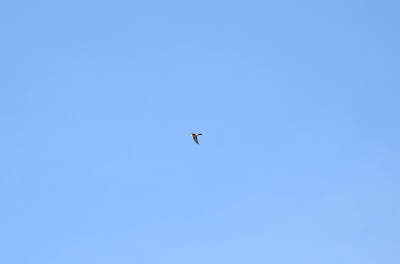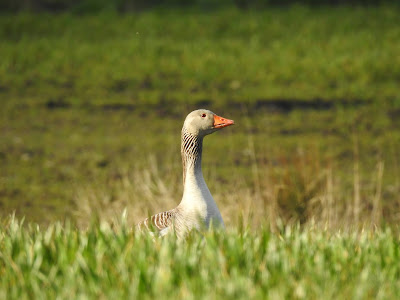Earlier this week Gail and I visited a farm of one of my clients in Bowland, that I have been working with, and providing conservation advice to manage a population of breeding waders for 20 years now. It's not just breeding waders, it's all of the wildlife, or it's a case of encouraging as much wildlife on to the farm, by creating and managing a number of different habitats.
We had 7 oktas cloud cover and a light easterly wind, as we set off on what would be a very pleasant four hours walk. Willow Warblers were a constant companion to us on our walk, and there had obviously been a decent arrival, and dare I say it, during this cold spring a first decent arrival, with ten singing males.
One of the main reasons for our visit was to survey the breeding waders, and try and assess how their populations are doing. I have mentioned numerous times recently, what a cold, late spring we are having, and I think this is also having an effect on the breeding cycle of waders this year. It was hard to say for definite what affect the spring is having, and as a result of this, I am going to have another look next week to try and get a better idea. I estimated that on the bit of the farm that we surveyed there was four pairs of Oystercatchers, 13 pairs of Lapwings, two pairs of Common Sandpipers and ten pairs of Curlews.
My Blog title of 'Tewits' refers to the breeding Lapwings that we were surveying, and Tewit is a Scottish and northern English name for Lapwing! In fact, the magazine that I used to produce for the members of the conservation charity that I used to work for, was called 'The Tewit'.
Even though it was 8:00 a.m. before we set off on our walk, we did have a number of Brown Hares, with at least 16 recorded in my notebook. You can't beat a Brown Hare; gorgeous animals! Besides the Willow Warblers, the only other warbler species we recorded was a singing Sedge Warbler in one of the wetland areas on the farm.
We did have two other summer migrants though, a male Cuckoo and a singing Redstart. The male Cuckoo was utilising a large area of the farm, and if I hadn't seen how far he was flying, I might have entered two in my notebook. At one point he flew directly over us 'Cuckoo-ing', and instead of just enjoying watching him fly over, as Gail did, I faffed around trying to photograph him, and ended up with just a dot against the sky as a result! At one stage, I could see the Cuckoo perched on top of a mature Ash tree in a hedgerow, and a number of birds (Meadow Pipits, Goldfinches and Chaffinches) were perched up round him. I wasn't sure that they were semi-mobbing him because he looks a bit like a raptor, or whether they know that Cuckoos are a brood parasite.
There wasn't any obvious vis this morning, other than the infrequent calls of Siskins and Lesser Redpolls that remained unseen. There were Tufted Ducks on all of the ponds, and the farm has a good breeding population of them. We recorded two pairs of Stonechats; one pair in the wetland complex and another along the edge of the fell.
Two Ravens commuted back and forth, occasionally displaying, and doing a complete roll as they do. Raptors were thin on the ground, and we had two Buzzards and a Kestrel. It looked a good morning for a migrant raptor, but it wasn't to be.
On this date (26th April) in 1989, I was at Long Point Bird Observatory on Lake Erie in Ontario, Canada, with Phil from our ringing group. We went for four weeks, and had a fabulous time witnessing migration action at this superb bird observatory.
On this particular morning, it was mild, with full cloud cover and intermittent drizzle, and we had a huge fall of birds, but the number of species was limited. We had some nets open, and after a short while we had to close them because we were catching so many birds. The main species arriving was Golden-crowned Kinglets and we could hear them bumping into the banding lab windows, and they were even coming into the cabin!
We estimated that there was at least 1,800 Golden-crowned Kinglets at the Breakwater field station that we were running. This field station is on a wooded ridge that juts out into some wetlands, about five miles from the base of Long Point. We extracted somewhere in the region of 2-300 Golden-crowned Kinglets, but rather frustratingly at this time Long Point didn't hold a band small enough to fit them, so they had to be released unringed! They do now by the way.
We also recorded 200 Brown Creepers (ringed 47), 100 Ruby-crowned Kinglets, 60 Hermit Thrushes (9 ringed), 75 Chipping Sparrows (12 ringed), 15 Field Sparrows, 25 White-throated Sparrows and 200 Slate-coloured Juncos (40 ringed). A busy morning!
Other species encountered, but in lesser numbers included, a female Northern Harrier, 50 Common Grackles, 5 Pine Warblers (1 ringed), 5 Myrtle Warblers (2 ringed), Eastern Phoebe, 70 Tree Swallows, 3 Brown Thrashers and a Savannah Sparrow.
I'm hopefully out ringing in the Willow scrub at weekend, but it will be nothing like that morning at Long Point 32 years ago!




























